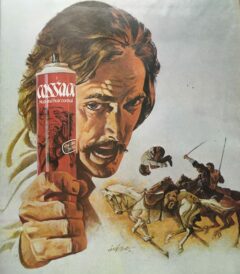We may have been in awe of top professional footballers in the 7os but their homes were oddly uninspiring

As has been referenced in previous posts in this blog, football magazines of the 60s and 70s such as Shoot! and Goal often took us into the lovely homes of footballers (See Shoot and Goal Magazine: When Football Was Football and Not Just A ‘Product’ below). At a time when players were much more accessible and the idea of ‘image rights’ hadn’t even been thought of, they introduced us to their trophy wives and families and gave us an insight into what it must be like to be on a £100 quid a week. We young readers didn’t just have to dream.
As well as showing us the upmarket styles and what passed for luxury then, it also made the players that little bit more human, rather than the demi-gods they appeared to be on Sportscene, Match of the Day or The Big Match (See The Big Match: Sunday In The Park With Brian below). It seemed footballers always had to be married, maybe to prove their virility, their status and even they had to follow the social conventions of the 60s and 70s. Georgie Best and his legions of ‘dolly-birds’ seemed an exception to the rule. At least, an exception in the fact he remained single until well into his 20s. Some married footballers, therefore, had to be a little more discreet at their local night spots in the days before the ever- prying eyes of tabloid newspapers. A cursory bit of research highlighted the fact that not all the subjects of the following picture profiles are still with the ladies they were with back then. And some of the players represented are not even with us anymore, sadly.
The pictures were taken by Ray Wright, photographer of Goal magazine, and offer us an insight into the luxurious and sometimes not so luxurious lives of top players. And they depict a time when footballers were not the untouchables many of the footballing superstars of today are now. For some reason Ray often asked the players and their lovely wives to pose outside their houses with a few random domestic objects, clearly to try and add a bit of extra detail and character to, what could be, deadly dull images. For many of these pictures Ray was kicking into the wind, sadly. But it also had the effect of making the players more human, reducing them to our level which 13 year olds like myself didn’t really want to see, necessarily.
1. Stewart Houston : Manchester United
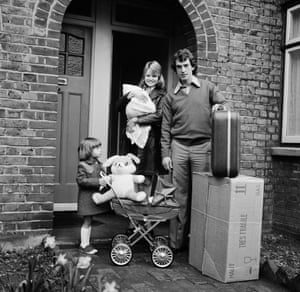
I’ve started with this one as it seems quite different from the other cosy domestic scenes below. The Houston family look like they’ve just been evicted from their council house in a scene reminiscent of Ken Loach‘s gritty drama Cathy Come Home. Stewart Houston played for Manchester United, then, as now, one of the wealthiest clubs in the country. One would think he’d have been able to afford a detached rather than a semi-detached dwelling, but clearly not. I’ve mentioned in a previous post that when Tommy Docherty was given the job of Manchester United manager in 1973 he was on a three year contract at £30,000 a year. Now that equates to just under £400,000 today. A lot of money you might think but not when you consider today’s English Premier coaches and players are on £squillions per annum. So what was poor old Stewart being paid as this pic was taken around the same time as Docherty took over? It’s true it was much cheaper to get into football matches in those days and TV revenue was a drop in the ocean compared to now, but someone at Man U was making a killing and, going by this pic, it wasn’t the players or manager.
2. Geoff Hurst: West Ham United
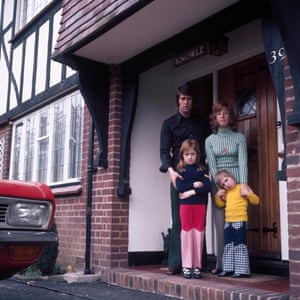
Now this is more like it. Not only in living colour but Geoff and his lovely wife Judith are standing in front of their mock-Tudor mansion, as befitting a top 70s player. Now one would expect a 70s footballer, let alone a West Ham footballer, to live in a mock Tudor house and Geoff is only too happy to oblige.
The car just impinging into the shot looks to me like a Vauxhall Viva, a car synonymous with the 70s. If it isn’t it’s something very similar. Surely Geoff, who would have been one of the better paid English footballers, must have been able to afford a fashionable Sunbeam or even a Capri? Maybe he just wasn’t a petrolhead but footballers were always about obvious consumption were they not? Possibly the mock-Tudor house took up too much of his income. And, of course, there were few lucrative boot or equipment deals in those days.
The lovely Judith, who, like some of the other footballers’ wives, doesn’t seem overjoyed at having to pose on her doorstop for the Goal photographer but for a hundred quid, I suppose, it’s probably worth the effort. Geoff’s marriage to Judith has certainly gone the distance and, according to the good people at Wikipedia, is still going strong. Good on you Geoff, a fine effort in an industry not renowned for fidelity.
3. Mick Mills: Ipswich Town
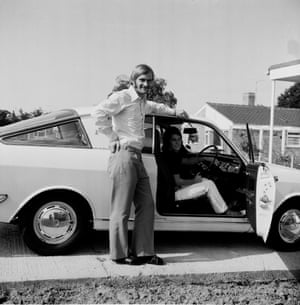
Mick Mills was a long-serving team captain of Ipswich Town and highly capped England player when this domestic scene was captured. Not long before this photograph was taken of Mick and his lovely wife Sue in 1973, he was the subject of Shoot! magazine’s equivalent of this Goal feature, ‘At Home With…. I remember at the young age of 12 feeling a bit sorry for Mick. The Shoot! photo spread featured only Mick and his Boxer dog. Mick was pictured mowing his lawn and playing with his dog as opposed to the other subjects who were pictured with their families and children in a variety of mundane activities. Now, of course, I realise Mick was what all young(ish) relatively well paid footballers should have been. Glamorously single. But by the time the Goal photographer comes calling he’s not only got himself a bird, but also a wife! Mick may have marauded up and down that Portman Road right flank but there were no flies on him when it came to pulling the ladies in seemingly double-quick time. At first I wasn’t entirely convinced by the scene of domestic bliss above. His lovely ‘wife’ Sue is tucked away in a car that is certainly much more in keeping with a footballer’s lifestyle than Geoff Hurst‘s Vauxhall Viva, but she’s very much in the shade. I can’t help thinking she could have been from Footballers’ Wives Central Casting just for the day. And would she really allow him to wear flip-flops with trousers? But a bit of internet research reveals they are still very much together and living in Suffolk. My cynicism about the lives of 70s footballers is seemingly misplaced…..
4. David ‘Waggy’ Wagstaffe: Wolves
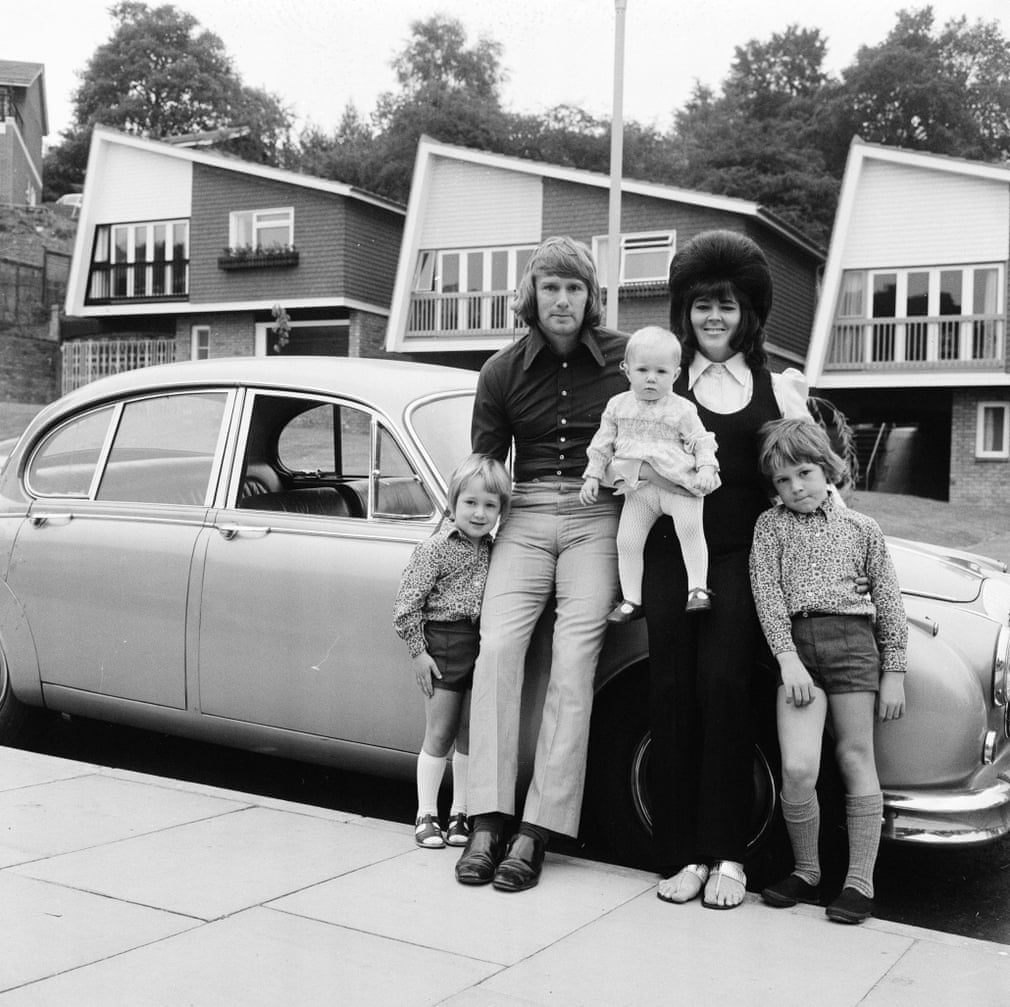
…but hang on a cotton-picking moment because here’s Wolves‘ flying winger Dave ‘Waggy’ Wagstaffe and his severely coiffured wife, Barbara. Now this is much more like a 70s footballer’s lifestyle. They’re leaning against the E-Type Jag in a 60s up- market housing estate in the West Midlands. I mean they’ve even got a balcony! Today, tabloids never refer to a footballer’s home as a ‘house’, it’s always a ‘mansion.’ But here, as is the case in most of these pics, it’s definitely a ‘house’, as stratospheric wages for top players were a long, long way off. And this picture, I believe, demonstrates the difference between playing for a London club where you’re paid more, probably, but your money doesn’t go as far and playing for a northern club where you earn less but everything’s that bit cheaper. Hence the Jag and Barratt home as opposed to the Vauxhall Viva. Waggy isn’t exactly beaming about his enviable life-style in the pic and research showed his partner for the final twenty years of his life was a woman named Val. Sadly, Waggy is no longer with us and the lovely Barbara had slipped out of the picture during the 15 years after this picture was taken.
5. Tommy Taylor: West Ham United
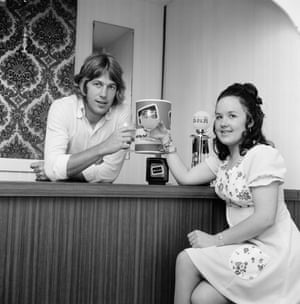
I bet he drinks Carling Black Label!
Ask anyone during the 70s what they would want in a money-no-object, built- to-their- specifications fuck-off house, most would say ‘a bar’ followed by ‘a colour TV’. It was the apotheosis of glamour, sophistication and luxury. And here we see West Ham stopper Tommy and his lovely wife, Pat, enjoying a vodka and Kia Ora. Mind you, Pat doesn’t look old enough to be drinking alcohol and they don’t look the most obvious of couples. It’s unknown whether Tommy and Pat are still together although Tommy is still very much with us and still involved in football, coaching a team in Finland. Bet he doesn’t drink Carling Black Label anymore, though.
6. Harry Redknapp: West Ham United
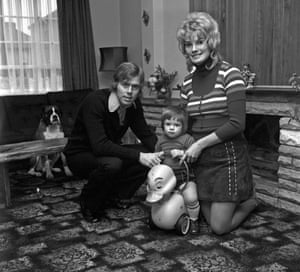
And who do we have here in their lovely Chigwell bungalow. None other than a young ‘Arry Redknapp and his lovely wife Sandra! There’s a great deal of those 70s favoured building materials, wood and natural stone, in evidence and we had a carpet and fireplace just like that. The fireplace does not appear to be in use as central heating had just become de rigeur for those that could afford it. Such as top footballers.
A few years ago Sky Sport ran a football nostalgia series called ‘Bobby Charlton’s Football Scrapbook‘ in which Bob discussed matches from his illustrious career with the estimable Dickie Davies. Excellent footage of sixties and seventies English First Division games was shown followed by a shockingly dull analysis by the lugubrious Bobby. Poor old Dickie was flogging a dead horse most of the time as he tried to jazz up proceedings with a few gags which fell on Charlton stony ground. One bit of footage featured Harry Redknapp himself in an early 70s West Ham game. Harry was a popular winger, not to mention an unlikely sex symbol, for the Hammers playing 149 games between 1965 and 1972 scoring a rather disappointing, to say the least, 7 goals. During this featured match two teenage girls, rare in 70s football, festooned in West Ham scarves and bell-bottomed Brutus jeans, ran on to the pitch and started kissing an embarrassed ‘Arry. After the action was shown we were returned to the studio where an increasingly desperate Dickie giggled about the incident only to be immediately slapped down by Bobby who morosely exclaimed ‘..yes, but no one should ever run on to the field play.’ Boring old twat.
‘Arry and the lovely Sandra are still very much together and, interestingly, ‘Arry’s former West Ham team mate, Frank Lampard married Sandra’s twin sister Patricia. How odd.
Despite him being dragged through the courts on a number of occasions to face increasingly serious financial charges, nothing has been pinned on him, of course, which suggests his life has been as spotless as the fireplace in the picture above.
7. Gordon Bolland: Millwall
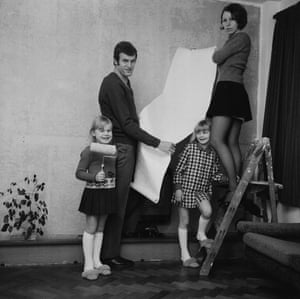
Few people other than Millwall fans of a certain age will remember Gordon Bolland. Other than those, that is, who watched Match of the Day during the 70s. For it was Gordon Bolland who won Match of the Day’s ‘Goal of the Month‘ for September 1971 with a screamer against Bristol City. And that was about as good as it got for Gordon although he played for Millwall successfully for 7 years and was inducted into their Hall of Fame.
When the Goal photographer came to call on the Bolland family they just happened, fortunately, to be doing a bit of home decoration at the time, so he sent the unnamed Mrs Bolland up the ladder in mini-skirt and high heels. This went down like a fart in a spacesuit with Mrs Bolland, it seems, as not only is her underskirt showing but her expression would curdle milk. I wouldn’t want to be around when the Goal photographer packed up his gear and drove off. He may have a BBC trophy for one of the best goals of 1971 but that’s not going save him from a right kicking.
8. Denis Law: Manchester United

The great Denis Law was not only a prolific goalscorer but was prolific in other departments too. It’s little wonder the lovely Sandra Law is sitting down after having so many children in such a short space of time. Luckily for her they decided to call full-time on any more procreation and she could, at least concentrate on bringing up a houseful of toddlers. Poor Sandra. There should be a Law against it.
Denis and Sandra met in their teens at an Aberdeenshire dancehall in the 50s and are happily still together. Their emotional symmetry is very much at odds with the decor in their lovely 70s living room. Never have so many styles clashed so menacingly in such a small space. A bit like The Lawman’s effect on opposing defences. Sandra’s blouse and the tartan of the kids’ kilts just add to the psychedelic melange. It’s a bit like one of those popular 70s posters where you had to try and spot figures somewhere in the busy detail. And check out the new central heating in the corner. Denis’s status at Manchester United has clearly allowed him to splash out on such luxuries. It reminds me a bit of when the also legendary Jocky Wilson won the World Darts Championship and was asked by a reporter what he was going to do with the all the money. ‘We’re gonnae get the hoose rewired,’ replied Jocky.
9. Alun Evans: Aston Villa
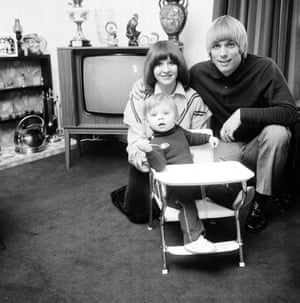
Alun Evans was one of those 70s players who are virtually forgotten despite playing over 250 top level games in the top English leagues. He is best remembered as a Liverpool player between 1968 and 1972. He never really made it at that top level and some believe it was because while a Liverpool player he was attacked and glassed in Wolverhampton night-club and was never really the same again. A reminder of just how violent football could be in the 70s.
We see him here with his lovely, again unnamed, rather young looking wife surrounded by some chintzy ornamentation. In those days, maybe it still happens, players were accommodated in ‘club houses’ so they needn’t have to worry about furnishing it. The local 70s equivalent of IKEA would come round and furnish it, which looks like what has happened here. Evans eventually ended up in Australia where he got married again and had more children. So this is one marriage that clearly didn’t last.
10. Peter ‘The Cat’ Bonetti: Chelsea

So here we have recently sadly deceased Chelsea and England goalie Peter ‘The Cat’ Bonetti and family. As this was the early to mid-seventies Bonetti was already an established first team player at Chelsea and an England international. It’s fair to say, however, that Bonetti’s international career never really recovered from England’s defeat to West Germany in the 1970 World Cup as many England fans blamed him for some of the goals, although I don’t really believe the overrated Gordon Banks would have been able to do much about them either. Luckily that aberration didn’t affect his footballer’s lifestyle and here we see the Bonettis outside their ‘mansion’ in the leafy suburbs somewhere near London. His dinky little open top car (despite having four kids) is very chic and certainly what we’d expect a 70s footballer to be driving. I wonder if he has a Hurstian Vauxhall Viva in the garage also? He’ll need something roomy for all his offspring to clamber into. And have you spotted the bonus ball in the corner? A fancy caravan, impossibly exotic then and very handy when you have a large family when a week in Marbella might stretch the purse strings, even for a top footballer.
11. Billy ‘Bonzo’ Bonds: West Ham United
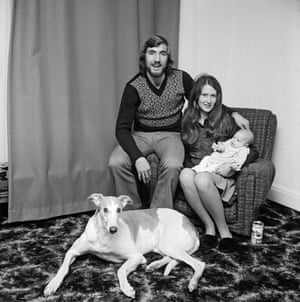
Sharp-eyed readers may have noticed that the bulk of the above subjects all played for London clubs. And of these London players, most played for The Hammers. There are a few obvious reasons for this I suspect. Firstly, the photographer, Ray Wright, will have been London-based and it was easier just driving round to local players’ mansions than taking a three-day camel ride to Newcastle or Liverpool. Secondly, the glamour players (Bestie excepted) were all based in London and although rarely league contenders, the perception from readers outside the Home Counties (as they were and still are patronisingly referred to by the media), West Ham were pretty glamorous compared to Crystal Palace, Fulham and even Chelsea.
Here we have Billy ‘Bonzo’ Bonds at home with his family in his fairly featureless mansion. Apart from a regulation highly patterned carpet and non-matching armchair, there’s not really much here for analysis in this rather bland domestic scene. Although Marilyn has kept her baffies on and is that a can of beer at the side of the chair? Whether it is or not, you’d have thought they’d have tidied up before the shoot. And what about that dog? It looks like a cross between a greyhound, a Great Dane and some nuclear fission. My guess is photographer Ray just wanted to get the photo taken and away before Cujo ripped his throat out. You can see the mutt is just mulling over the possibility as the pic is taken.
It’s fair to say it was a different world then. As the man said, the past is a foreign country. As I have said in previous football posts, players then were more accessible and their lifestyles weren’t hugely different from our own in many ways. Players in the 70s were really just better-than-averagely paid artisans, even though lots of schoolboys worshipped them. How many top players nowadays would invite a photographer into their ‘mansions’ today? Unless, of course, it was for Hello magazine with their unlimited budget.
Today’s footballers may be obscenely reimbursed for their efforts, but few really know what to spend their cash on other than another Rolex, Aston Martin or …or…I’m struggling to think of anything else.
In 2003 when top footballers’ wages were beginning to be paid in wheelbarrows, ex-footballer Jamie Redknapp published a magazine called Icon. It was aimed at those in the social stratosphere way above ordinary punters. Available in exclusive First Class airport lounges and sent free to anyone who had a few million quid to spare, it advertised the sort of tasteless things a tiny percentage of the population could afford. By calling the puffed-up publication Icon, it implied its readership was those people us proles were expected to look up to and revere, almost in a religious fashion. Well, speak for yourself, Jamie but we’ll decide who we feel deserve revering, thanks. It was a product of a time when some people were becoming so rich they occupied another dizzying plane within society. Some things never change.
The mag went bust in 2010 amidst a blizzard of debt. I mention this just to highlight the differences between the honest pros above and the image-obsessed, untouchable, high-flying businessmen who turn out for the top clubs nowadays.
And you thought Tommy Taylor‘s bar was flash?
